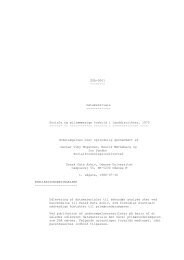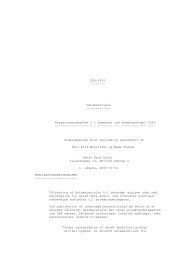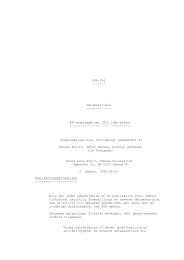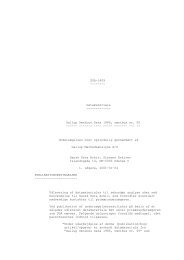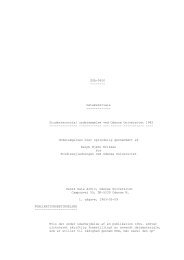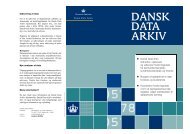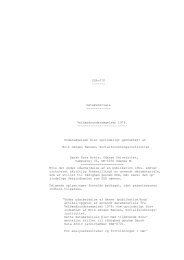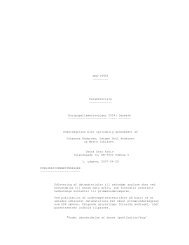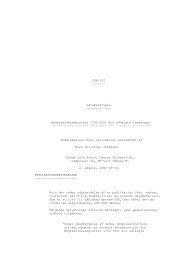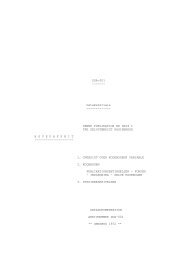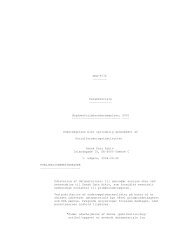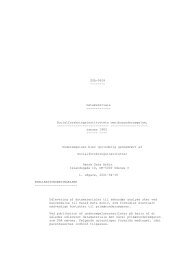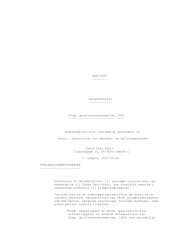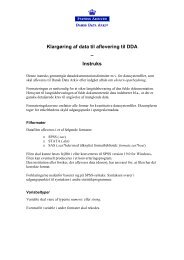Metode og Data nr. 86 - DDA Samfund - Dansk Data Arkiv
Metode og Data nr. 86 - DDA Samfund - Dansk Data Arkiv
Metode og Data nr. 86 - DDA Samfund - Dansk Data Arkiv
You also want an ePaper? Increase the reach of your titles
YUMPU automatically turns print PDFs into web optimized ePapers that Google loves.
<strong>DDA</strong>-2300 „Dental Care and<br />
Dentists’ Services, 1995“<br />
(Eli Schwarz)<br />
The data for this survey were collected by the<br />
Danish Gallup Institute as part of an omnibus<br />
in weeks 34-37, 1995.<br />
The survey examines dental care and dental<br />
conditions and contains questions about:<br />
Whether the respondent went to the dentist<br />
regularly during school; what the respondent<br />
did concerning his/her teeth from he/she left<br />
school and till the age of 20; when the<br />
respondent last went to the dentist; whether<br />
the respondent visits the dentist in the spare<br />
time or during working hours; whether the<br />
respondent gets a wage deduction if he/she<br />
visits the dentist during working hours;<br />
whether the respondent has visited a dentist<br />
regularly within the last five years; reasons<br />
why not (e.g. financial conditions, laziness,<br />
fear of the dentist, lack of time, long period of<br />
waiting, illness, denture); which kind of<br />
treatment the respondent had the last time<br />
he/she went to the dentist; how many teeth the<br />
respondent has left; own assessment of the<br />
teeth; whether the respondent has sore or<br />
bleeding gums in connection with tooth<br />
brushing; whether the respondent has received<br />
guidance to correct tooth brushing or use of<br />
toothpick or dental floss in connection with a<br />
dental visit within the last year; whether the<br />
respondent has a denture and when he/she got<br />
it; whether the denture was made by a dentist<br />
or by a teeth technician, reasons for the<br />
choice; and how the respondent feels in the<br />
dentist’s waiting room and in the dentist’s<br />
chair while the dentist gets ready for drilling<br />
or a tooth cleaning.<br />
File dimensions: 1002 cases, 82 variables.<br />
<strong>DDA</strong>-2482 „Sexual Aspects in the<br />
Careers of Doctors, 1993“<br />
(Helle Jacobsen and Grete Korremann)<br />
In 1992 the Nordic Council of Ministers<br />
decided to implement a project on the<br />
competence development, promotion and<br />
leadership qualities of women. The project<br />
formed part of the Nordic Council of<br />
Ministers’ action pr<strong>og</strong>ramme for equal status<br />
co-operation in 1989-1993. In this action<br />
side 57 <strong>Metode</strong> & <strong>Data</strong> <strong>nr</strong>. <strong>86</strong> – 2002<br />
pr<strong>og</strong>ramme the status and influence of women<br />
in various occupations was emphasized as a<br />
particularly important area.<br />
The background of the project was that a<br />
number of surveys have mapped out that<br />
there are barriers to the promotion of women<br />
and to women reaching leading position.<br />
However, no analyses have been available<br />
which have systematically examined the<br />
careers of women and men in the same<br />
occupation.<br />
The medical profession was chosen<br />
because there are relatively few women in top<br />
jobs, while it is a career increasingly chosen<br />
by women. This had resulted in statements<br />
expressing fear of the future prestige of the<br />
occupation, of it becoming necessary to fix<br />
quotas of male students, of certain specialist<br />
fields becoming understaffed, etc.<br />
The survey had two main purposes:<br />
First, it was to examine the careers of women<br />
and male doctors in order to find out whether<br />
there were any differences, which differences<br />
and at what time in the professional career<br />
these differences appeared. Previous surveys<br />
of the working conditions and living<br />
conditions of doctors had already shown that<br />
there were differences in the family situation,<br />
choice of specialist field, and number of<br />
leading positions.<br />
Secondly, the results of the survey were to<br />
be used as the basis for an interview survey<br />
which, by means of qualitative interviews,<br />
should make an attempt at examining the<br />
differences more closely in order to find out<br />
what underlies the differences. Therefore,<br />
emphasis was put on the doctors’ opinion of<br />
why women and male doctors were in<br />
different positions in the system. Unfortunately,<br />
it turned out that is was not possible to<br />
carry out the interview part.<br />
The survey contains a comparison between<br />
a group of women and men who graduated in<br />
1982 in Denmark, Finland, Norway and<br />
Sweden. Unfortunately, Iceland had to be left<br />
out as there was not a sufficient number of<br />
doctors who completed the questionnaire.<br />
File dimensions: 1000 cases, 219 variables.




